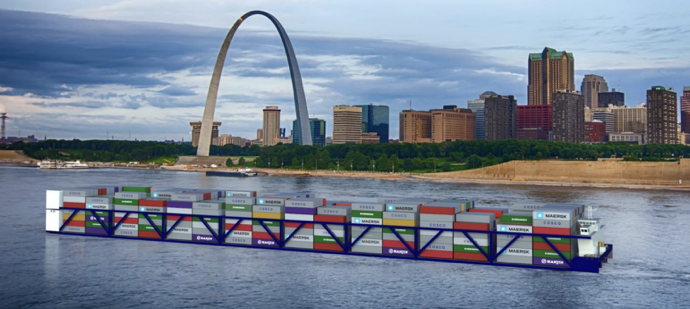Soybean farmers, faced with many challenges in the global marketplace, are exploring containerized shipping on inland waterways as a viable way to get their products to export facilities near the Gulf of Mexico.
Farmers, represented by the Soy Transportation Coalition in Ankeny, Iowa, are especially interested in a vessel design developed by American Patriot Holdings LLC, Miami, that would allow the transport of shipping containers throughout the inland system.
APH has been testing two self-propelled container vessel concepts for use on the Mississippi River. Its “liner” vessel has been specifically designed for the non-locking segments of the Mississippi River and its tributaries and would transport up to 2,375 TEUs (20' equivalent units) between Plaquemines Port Harbor and Terminal District (PPHTD) in Louisiana, the port complex along the Lower Mississippi River closest to the Gulf of Mexico, and Memphis, Tenn., and St. Louis. The liner would be able to travel at 13 mph upriver, compared to a traditional barge flotilla that would move at between four and five miles per hour, the study said. At 13 mph, the round-trip transit from Plaquemines Parish to Memphis would take six days, and 10 days round trip to St. Louis.
A smaller “hybrid” vessel would handle up to 1,700 TEUs, and be capable of transiting the lock and dam portion of the inland system. It would provide access to regions and communities located along the Mississippi, Illinois Ohio and Arkansas rivers, according to a study prepared by Informa Economics IEG that was completed in October. Future service for areas along the upper Mississippi River is now being evaluated.
Meanwhile, the study noted, PPHTD is developing a new container port terminal between mile markers 50 and 55 on the Mississippi River that will be the southern-most full-service port complex on the river and provide full intermodal service via river, rail, highway and air to and from the heartland. APH has agreed to develop a specially-designed gateway terminal at mile marker 55 with a 44' draft that can accommodate large ocean-going container vessels.
Informa compared the cost, speed and quality preservation of inland containerized shipping to the currently used options of moving containers via rail to the West Coast and bulk barge to the Mississippi Gulf export terminals, and concluded that this alternative is promising.
“New marine vessels, designed by American Patriot Holdings, present the potential to change dramatically the economics of containerized shipping along the inland waterways system as a container on vessel approach, rather than a container on barge program,” the study said.
A big advantage is speed. The study said the APH vessel will enable shipments of soybeans and other agricultural products destined to customers in China to be shipped six days faster than bulk barge shipments, and 14 days faster than containerized shipments via rail to West Coast facilities.
On cost, the biggest savings would be realized by using the container on vessel approach to get products to the West Coast rather than sending it by rail.
Loading soybeans onto a container near St. Louis, transporting it via rail to the West Coast and finally on an ocean vessel to Shanghai would cost $197.87 per metric ton. The APH Liner service would transport soybeans from St. Louis via container to an ocean vessel at the PPHTD and onto a customer in Shanghai at a cost of $108.88 per metric ton, a 45% savings compared to containerized shipping through the West Coast.
Barge transportation, however, will remain the cheapest mode. Moving soybeans from St. Louis via bulk barge to an ocean vessel at a Mississippi Gulf export terminal and onto Shanghai, would cost $79.80 per metric ton. “Bulk barge movements have a competitive advantage over container movements due to the differential in price. Bulk barge is expected to remain the predominate mode of transportation for the export of grain and soybeans,” the study said.
Barge companies are aware of this new concept, according to Mike Steenhoek, executive director of the Soy Transportation Coalition. “While it could be a source of competition, the main competitor is rail to the West Coast,” he said. “While there is a potential for competition with barges, it also presents the opportunity to increase the overall use of the inland waterway system and therefore, public support for investing in it. As more industries and communities benefit from increased traffic on the system, it is our hope that we’ll see greater support among elected leaders.”
Steenhoek said the Coalition is forming working groups among communities and regions along the waterways system that could benefit from this potentially new supply chain.





